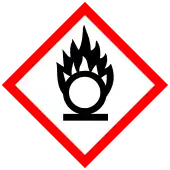| Identifiers | |
|---|---|
| |
3D model (JSmol) |
|
| ChemSpider | |
| ECHA InfoCard | 100.033.979 |
| EC Number |
|
PubChem CID |
|
| RTECS number |
|
| UNII |
|
CompTox Dashboard (EPA) |
|
| |
| |
| Properties | |
| In(NO3)3 | |
| Molar mass | 300.83 g/mol |
| Appearance | White solid |
| Density | 2.43 g/cm3 (pentahydrate)[1] |
| Melting point | 100 °C (212 °F; 373 K) (decomposes, hydrate) |
| Soluble | |
| Structure[1] | |
| Monoclinic | |
| C2/c | |
a = 10.35 Å, b = 9.17 Å, c = 11.25 Å α = 90°, β = 91.05°, γ = 90° | |
Lattice volume (V) |
1068 Å3 |
| Hazards | |
| GHS labelling: | |
  | |
| Warning | |
| H272, H315, H319, H335 | |
| P210, P220, P221, P261, P264, P271, P280, P302+P352, P304+P340, P305+P351+P338, P312, P321, P332+P313, P337+P313, P362, P370+P378, P403+P233, P405, P501 | |
Except where otherwise noted, data are given for materials in their standard state (at 25 °C [77 °F], 100 kPa).
Infobox references | |
Indium(III) nitrate is a nitrate salt of indium which forms various hydrates. Only the pentahydrate has been crystallographically verified. Other hydrates are also reported in literature, such as the trihydrate.[1][2][3]
Production and reactions
Indium(III) nitrate hydrate is produced by the dissolution of indium metal in concentrated nitric acid followed by evaporation of the solution:[1][2][3]
- In + 4 HNO3 → In(NO3)3 + NO + 2 H2O
The hydrate first decomposes to a basic salt and then to indium(III) oxide at 240 °C. Anhydrous indium(III) nitrate is claimed to be produced by the reaction of anhydrous indium(III) chloride and dinitrogen pentoxide.[2][4]
In the presence of excess nitrate ions, indium(III) nitrate converts to the [In(NO3)4]− ion.[1][2]
The hydrolysis of indium(III) nitrate yields indium(III) hydroxide. It also reacts with sodium tungstate to form In(OH)WO4, [In(OH)2]2WO4, NaInWO4 or In2(WO4)3 depending on pH.[5][6]
Structure
Only the pentahydrate has been structurally elucidated. The pentahydrate consists of octahedral [In(NO3)(H2O)5]2+ centers as well as two nitrates and is monoclinic.[1]
References
- 1 2 3 4 5 6 M. A. Malyarik; S. P. Petrosyants; A. B. Ilyukhin; Yu. A. Buslaev (1993). "Polyfunctionality of the nitrate group, coordination numbers of trivalent indium in nitrates complexes, and crystal structures of [In(NO3)(H2O)5](NO3)2 and HK6[In(NO3)4(H2O)2]3(NO3)4". Russian Journal of Inorganic Chemistry. 38 (12): 1849–1854. ISSN 0036-0236.
- 1 2 3 4 D. G. Tuck; E. J. Woodhouse; P. Carty (1966). "Co-ordination compounds of indium. Part III. Indium(III) nitrate species". Journal of the Chemical Society A: Inorganic, Physical, Theoretical: 1077–1080. doi:10.1039/J19660001077.
- 1 2 Galina V. Kozhevnikova; Gábor Keresztury (1985). "The state of indium ions in nitrate solutions: A Raman spectroscopic study". Inorganica Chimica Acta. 98 (1): 59–65. doi:10.1016/S0020-1693(00)90751-5.
- ↑ B. O. Field; C. J. Hardy (1964). "Volatile and anhydrous nitrato-complexes of metals: preparation by the use of dinitrogen pentroxide, and measurement of infrared spectra". Journal of the Chemical Society: 4428–4434. doi:10.1039/JR9640004428.
- ↑ Keita Yura; Karl C. Fredrikson; Egon Matijević (1990). "Preparation and properties of uniform colloidal indium compounds of different morphologies". Colloids and Surfaces. 50: 281–293. doi:10.1016/0166-6622(90)80270-E.
- ↑ Shcherbina, K. G.; Mokhosoev, M. V.; Gruba, A. I. Reaction of aluminum and indium nitrates with sodium tungstate in hot solutions [in Russian]. Zhurnal Neorganicheskoi Khimii, 1974. 19 (2): 396-399. ISSN 0044-457X.